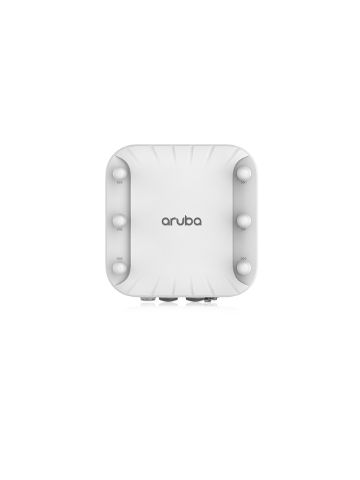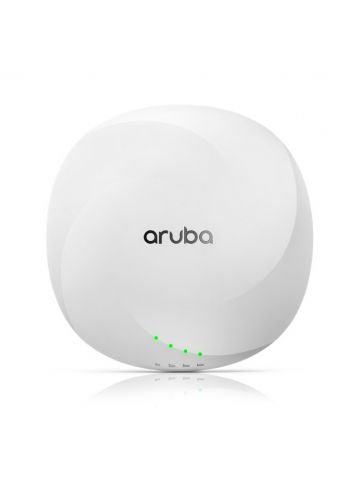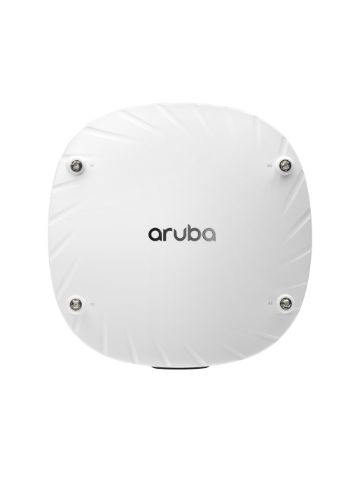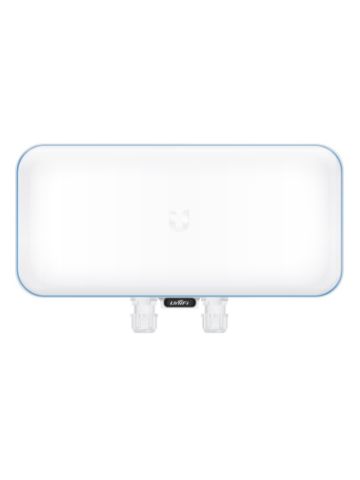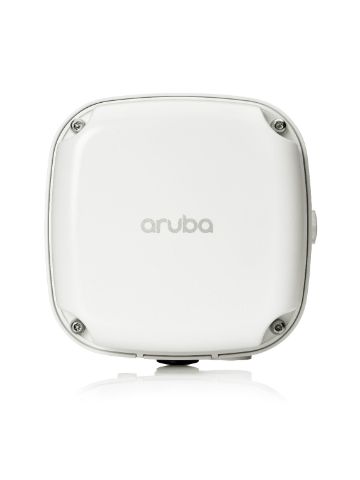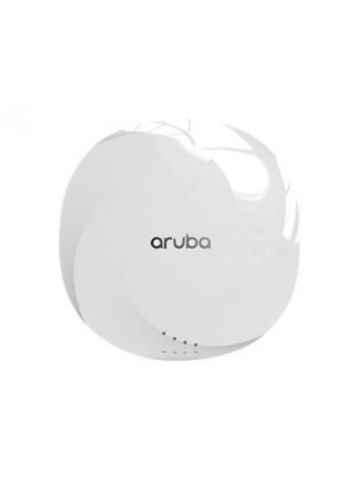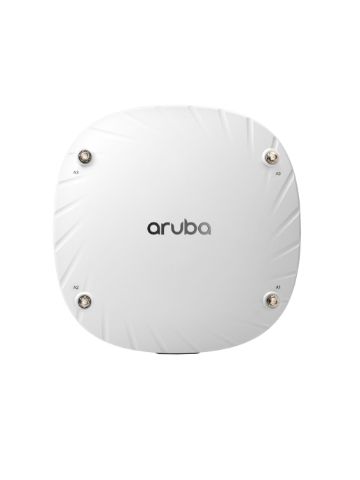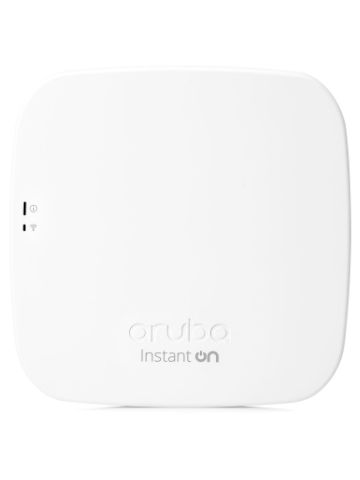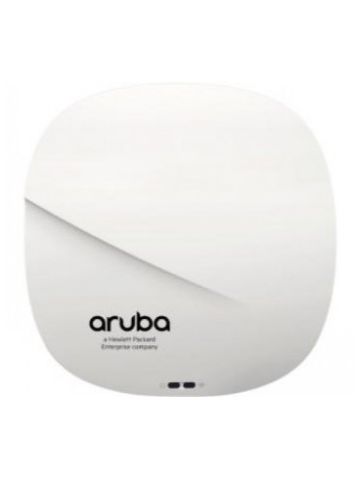Wireless Access Points
-
IN STOCKHPE Aruba AP-518 (RW) - Hardened - wireless access point - ZigBee, 802.11ac Wave 2, Bluetooth 5.0 - ZigBee, Bluetooth, W...
Brand: Aruba SKU: R4H02A Condition: NEW $2369,91 | $2843,89(Inc.VAT) -
IN STOCKHPE Aruba AP-575 (RW) - Wireless access point - Wi-Fi 6 - 2.4 GHz, 5 GHz
Brand: Aruba SKU: R4H17A Condition: NEW $2028,91 | $2434,69(Inc.VAT) -
IN STOCKAruba R7J38A wireless access point 4800 Mbit/s White Power over Ethernet (PoE)
Brand: HPE SKU: R7J38A Condition: NEW $1626,18 | $1951,42(Inc.VAT) -
IN STOCKHPE Aruba AP-534 (RW) - Campus - wireless access point - Bluetooth 5.0 - Bluetooth, Wi-Fi 6 - 2.4 GHz, 5 GHz
Brand: Aruba SKU: JZ331A Condition: NEW $1614,27 | $1937,12(Inc.VAT) -
IN STOCKUbiquiti Networks Unifi UWB XG 1733 Mbit/s White Power over Ethernet (PoE)
Brand: Ubiquiti Networks SKU: UWB-XG Condition: NEW $1310,91 | $1573,09(Inc.VAT) -
IN STOCKHpe Aruba Ap-567 (Rw) Wireless Access Point
Brand: Aruba SKU: R4W48A Condition: NEW $1256,32 | $1507,58(Inc.VAT) -
IN STOCKAruba R7J27A AP-635 Tri-Band WiFi 6E Access Point
Brand: HPE SKU: R7J27A Condition: NEW $1253,64 | $1504,37(Inc.VAT) -
IN STOCKUbiquiti UAP-AC-SHD-5 WLAN access point 1000 Mbit/s PoE White
Brand: Ubiquiti Networks SKU: UAP-AC-SHD-5 Condition: NEW $1117,19 | $1340,63(Inc.VAT) -
IN STOCKHPE Aruba AP-514 (RW) - Wireless access point - Bluetooth 5.0 - Bluetooth, Wi-Fi 6 - 2.4 GHz, 5 GHz - in-ceiling
Brand: Aruba SKU: Q9H57A Condition: NEW $1136,73$1068,52 | $1282,22$1364,08(Inc. VAT) -
IN STOCKUbiquiti Networks UBB-XG Building Bridge XG
Brand: Ubiquiti Networks SKU: UBB-XG Condition: NEW $1051,35 | $1261,62(Inc.VAT) -
IN STOCKHewlett Packard Enterprise Aruba Instant On AP12 (RW) (4x R2X01A) 1600 Mbit/s White Power over Ether
Brand: HPE SKU: R2X01AX4 Condition: NEW $993,89 | $1192,67(Inc.VAT) -
IN STOCKHPE Aruba Instant IAP-315 (RW) - radio access point
Brand: HPE SKU: JW811A Condition: NEW $973,30 | $1167,96(Inc.VAT)
How to Choose the Best Wireless Access Point in the UK & Beyond
The network infrastructure that is reliable, secure, and fast is the need of the hour in this age. But sometimes it becomes hard for your router, hub, or network switch to provide connectivity to all devices within the premises. You may need a wireless access point to eliminate these dead spots. WAPs or simply access points have become the most important pillar of any WiFi connectivity. These devices help all of your WiFi-capable devices such as mobile phones, tablets, desktops, and laptops, to access WiFi signals wirelessly. Given their critical importance, you need to choose WAPs carefully so that you can provide WiFi connectivity with ease and confidence. Concerning this, you can visit our WAPs collection, featuring top-ranked access points from industry-best brands.
In this write-up, we are going to discuss some features of Wireless Access Points so that you can make sure that the WAP under your consideration proves the most suitable for your needs and preferences.
Let’s start with the basics.
What is a Wireless Access Point?
Simply speaking, a Wireless Access Point (WAP) or access point is a device that helps wireless devices connect to the network. They are connected to a router, switch, or internet hub through an Ethernet cable and they in return convert the network from wired to wireless. They are placed strategically, often mounted in hallways or other central locations to provide strong signal strength as well as deep penetration through walls and other physical obstructions. But in some special cases where cable network reach is nearly impossible, you can also connect access points with Wi-Fi router wirelessly, but you have to have a stable internet connection.
The technology behind WAPs is WiFi standards. Over the years, these standards have evolved, featuring ever-sophisticated capabilities. The latest Wi-Fi 6 (802.11ax) and Wi-Fi 6E which offer advanced and cutting-edge features.
What are the Benefits of Wireless Access Points?
Here are some benefits of WAPs:
- They can provide strong signal coverage throughout the premises both indoors and outdoors.
- You can provide wireless connectivity to an increased number of users.
- Access Points help you establish a large transmission range.
- They can be installed to extend the range of an existing network.
- WAPs feature flexible installation and setup.
Now, we look at what features you should consider before making a final purchase.
What to Look for in Wireless Access Points in the UK:
Here are some features you look into.
• Controller-Based Vs Stand-Alone Access Points:
Both stand-alone access points and controller-based access provide a unique set of features and capabilities. As a thumb rule, stand-alone access points are more suitable for small home offices or businesses. They can provide enough capabilities to meet your network needs. The downside of these access points is that they cannot provide adequate bandwidth and load-balancing features, similarly, encryption is also weak. But if you want to make them adaptive for large businesses, you can install centralized control wireless LAN management software to cater to the needs of larger operations.
Controller-based access points are suitable for large corporations and firms. They come with advanced capabilities such as upgraded WPA2 encryption, advanced configuration and policy settings, centralized management, and firmware updates. The downside is their price, making them suitable only for large and crowded networks.
• Speed:
Needless to say, speed is the first and foremost consideration, measured in megabits or gigabits. Also, the WiFi protocol is the technology that determines the speed that any access point can support. Concerning this, here are some recommendations:
Ideally, you should look for 802.11ax or WiFi 6 access point, they can support up to 2.4 Gbps speed. Similarly, 802.11 ac wave 2 and 802.11 ac wave 1 are also protocols that can support 1.72Gbps and 866Mbps speed respectively.
• Wireless Security:
Encryption is the best available security measure to protect your network from unauthorized access and other cyber threats. Though access points don’t support firewall protection, many WAPs come with built-in encryption. You need to make sure that the access point you are considering supports updated WPA (second and third-gen) and WPA2 encryption.
• Single Band Vs Dual Band Vs Tri-Band Access Points:
In the market, you can find single-band access points, dual-band access points, and future-proofing Tri-band access points. Single-band access points operate on 2.4GHz frequency. At this frequency, they can provide networks to 30 devices at a 130m distance. However, this frequency is becoming obsolete because it is vulnerable to interference from other Bluetooth devices, hotspots, and electronic appliances.
Two-band access points operate on 2.4GHz and 5GHz frequencies. 5Ghz band is known for offering more consistent and stable connections, allowing users to provide reliable connections to mission-critical applications. You can avoid interferences as well.
Tri-band access points support three bands: one 2.4GHz and two 5GHz bands. You can enjoy more bandwidth, less interference, and enhanced device support. Tri-band APs are now futuristic, allowing you to meet your network needs for a considerable period without any investment in purchasing new hardware.
• Internal vs External Antennas:
The efficiency of any access point also depends upon antennas. As a thumb rule, internal antennas are more suitable for indoor deployment whereas external antennas are recommended for outdoor settings such as commercial, businesses, and the like.
Normally, access points are equipped with internal antennas. Alternatively, they also feature RF or Radio Frequency Ports, allowing you to connect external antennas. You are recommended to deploy directional antennas for Point-to-Point communication. For instance, external omnidirectional antennas can help you establish wider, even 360-degree, point-to-multi-point indoor and outdoor coverage.
• Advanced Features/Technologies:
Here are some technologies that you should look into:
1. MU-MIMO and OFDMA:
Multi-User Multiple Input Multiple Output or MU-MIMO technology is a must-have feature, enabling access points to provide stable connections to multiple devices at a time. It helps access points to transmit data in multiple directions at a time, improving network speed & performance.
Similarly, Orthogonal Frequency-Division Multiple Access (OFDMA) is also a tech spec that you should look into. It works in close partnership with MU-MIMO and further enhances the network speed and device capacity.
2. Power Over Ethernet or PoE:
PoE is fast becoming the first choice for network administrators. PoE allows you to transmit data and power through a single cable, eliminating the need to install separate cables. You can thus simplify device installations and maintenance, clearing cable cluttering and improving the aesthetics of your workplace.
3. Beamforming:
Beamforming enables access points to transmit data to specific receiving devices, improving signal quality and enhancing overall network performance.
4. Ethernet Ports:
Ethernet ports can help you establish wired connections with bandwidth-intensive devices. You can thus make sure that mission-critical applications continue receiving requisite bandwidth. Therefore, look for an access point that features at least one ethernet port.
How Can We Help You?
Morgan Ingland Ltd is the leading value-added IT firm in the UK, offering top-notch and cutting-edge networking solutions and services at the most affordable price. We collaborate with industry-best Access Point manufacturers TP-Link, Ubiquiti, Netgear, Aruba, Juniper, D-Link, Extreme Network, and more to help you provide stable, secure, and reliable Wireless connections. Contact us today and elevate your networking experience to the next level.
